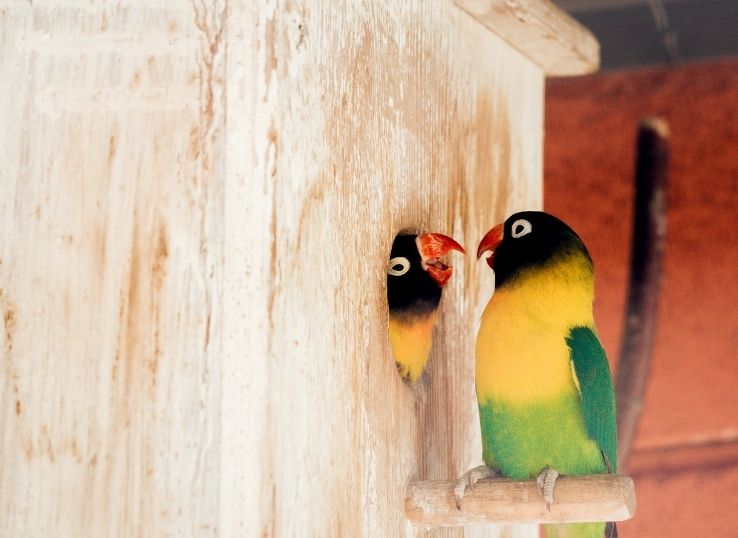Black-Collared Lovebirds ( Interesting Facts)
Last Updated on July 28, 2022 by Ali Shahid

This bird belongs to the Agapornis genus of lovebirds and is a small bird with a black chest. A species of pet bird native to Central African regions, these lovebirds are also known as Swindern’s lovebirds. Because these lovebirds are region-specific to Africa, they can be difficult to keep as pets.
Because of their special dietary needs, which mostly come from native figs, the Black-collared Lovebird is rarely kept in captivity.
Pet shops rarely stock these birds because they do not survive well in captivity without the fig. There are many parrot species commonly kept as pets, including the Black-collared Lovebird, which forms strong bonds with its owners.
Breeders and natural mutations create a variety of color mutations from these intelligent, lively, and beautiful creatures. Continue reading to learn everything you should know about black collared lovebirds.
Black-collared Lovebirds Habitat
A large area of equatorial Africa is home to Black-collared Lovebirds. Their habitats include forests in Cameroon, Ghana, Liberia, Gabon, Côte d’Ivoire, Equatorial Guinea, Gabon, the Democratic Republic of Congo, the Republic of Congo, and the Central African Republic.
These lovebirds thrive in the upper portions of the forest canopy among fir trees, their native wild habitat. They are shy animals, making it difficult to spot them in the wild.
Appearance
It is a small lovebird, with a maximum height of 5.1 inches (13 cm). A precise body length measurement for black-collared lovebirds cannot currently be provided due to their unknown wingspan.
The appearance of the Black-collared lovebird varies between juveniles and adults. Green adults tend to have a narrow, black nape. Their neck is covered in a dull yellow band. This deep blue or local color is evident on the lower back and carries on through the upper tail covers that are mostly black.
Black is typically the color of the primary and secondary feathers on the adult Black-collared lovebird. The underwing is green, rounded off with black tips, while the tail is red and green. Yellow eyes and gray or black bills are typical.
Their wings are pale blue as juveniles, and their backs are pale blue to their tails. There is an orange tone running through the tail feathers that gives them an overall dull appearance. There are black and gray bills as well as brown eyes.
Temperament
Due to the rarity of these birds being kept as pets, their characteristics and potential as pets are not well understood. Generally, though, Lovebirds are friendly, courteous, curious, and seem to always be on the move.
Their owners tend to form strong bonds with them, although if they are kept together in pairs, they will rarely interact with humans. It is vital for a single Lovebird to interact with its owner and to have toys, ladders, and swings available at all times.
Breeding
In aviculture, little is known about these birds’ breeding habits since they are rarely found in the wild. Both the male and female, black-collared lovebirds are observed to be monogamous and sexually mature between the ages of nine and ten months. In this species of lovebirds, monogamy plays a key role in their social behavior.
Diet and Nutrition
It is nearly impossible to provide for Black-collared Lovebirds outside of their natural habitat since they require native fig seed or fig flesh as a major component of their diet. These figs are essential to their survival and reproduction in captivity, and many will soon die without them.
Due to this reason, there have been no attempts to keep these birds as pets in the United States or Europe. Experts also agree that they cannot adapt to captive life. As well as consuming insects, larvae, and seeds from the surrounding area, they feed on small bugs.
Sound
Unfortunately, there is not enough documentation of these birds’ communication behavior to be able to describe them with precision. Large flocks continuously chatter and whistle when they assemble for food or to nest.
Threat
In some parts of its range, this species is rare. Population estimates are difficult due to the huge area, but there is no significant threat to the species. IUCN’s Red List of Threatened Species evaluates the Black-collared lovebird as not threatened.
Would this bird be able to live in captivity?
Many lovebirds live reasonably long in captivity and can be kept in captivity without any problems. Unfortunately, the Black-collared lovebird is inaccessible to lovers of this bird. In captivity, breeders have never been able to preserve this bird for longer than a half-year without reproducing.
Moreover, it is unable to export products from Africa because its food is heavily reliant on figs, which are extremely expensive and are buried 30 meters underground. For these reasons, it is impossible to cage her.
It is also a bird that does not adapt well to a life in captivity, especially if it is brought into captivity at a young age. Because their food is so special, they cannot be raised in aviaries because they do not like to be locked away.
As more and more of these birds are disappearing from the wild, some countries have begun banning their export for fear they will disappear altogether.
Frequently Asked Question
How long does a Black-collared lovebird live on average?
Black-collared lovebirds live for an average of 10-15 years.
What is the weight of a black-collared lovebird?
A Black-collared lovebird weighs around 35 grams (1.2 oz) when fully grown.
What is the sale price of a Black-collared lovebird?
As black collared lovebirds are extremely rare and can’t be purchased from pet stores, their cost is unknown.

